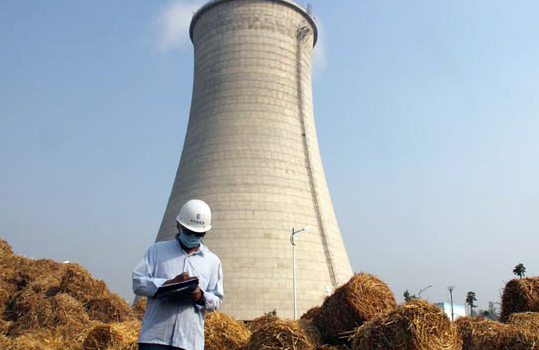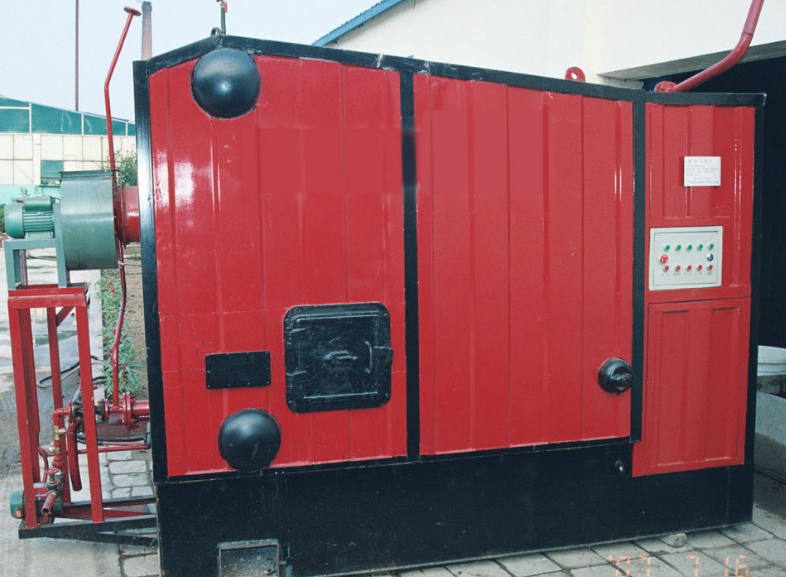General technology for hydrogen production from biomass
(1) Gasification and reforming
Biomass is considered to be one of the most abundant and renewable hydrogen production resources. Biomass gasification is a good process for hydrogen production. The dried raw material is pyrolyzed, then the intermediate product is burned, and then the subsequent compound is gasification. This process is carried out in a reactor called a gasifier, which operates at a higher temperature (700 to 1400 ° C) in the presence of a medium such as air, O2, vapor (H2O), or CO2. Unlike combustion, ideal pyrolysis and gasification processes convert the chemical energy of organic materials into a mixture of gases, organic liquid molecules, and solid coke. These methods are considered advantageous for future hydrogen or syngas production from biomass, which can meet environmental emission requirements and achieve cost effectiveness. Gasification of biomass in water vapor, air or oxygen media can produce gas mixtures of different hydrogen concentrations. Among them, water vapor gasification produces a higher hydrogen concentration than air gasification or oxygen gasification, and the resulting gas has a better calorific value. In a high thermal environment, biomass will undergo partial oxidation, steam reforming reaction or both reactions, resulting in syngas and solid coke. The resulting solid coke can be further reacted to hydrogen, carbon oxide and methane. The whole reaction process of biomass gasification is as follows:
In the first step of the gasification reaction, the thermal degradation of biomass produces crude syngas containing lighter volatiles. Further reaction and gasification efficiency depends on the gasification medium and process parameters. The product of biomass gasification is mainly a gas component, so this method is more suitable for producing hydrogen than pyrolysis. Effective biomass gasification relies on the development of low-cost feedstock, improved method efficiency, reduced installation and operating costs, and reduced environmental impact.

Tar formation during biomass gasification is a major concern as it poses operational problems and reduces the quality of the gas produced. Tar is a viscous liquid composed mainly of high-end aromatic hydrocarbons and heavy metals. High temperature cracking, steam reforming and partial oxidation can reduce tar production and improve the quality of the final product. In order to improve hydrogen production technology, several recent reports have investigated hydrogen conversion using different types of biomass, different experimental devices, and different catalytic pathways. The use of catalysts is very important, which can improve productivity and hydrogen production by facilitating the cleavage of C-O and C-C bonds. In addition to catalysts based on the metals nickel (Ni), zinc (Zn), platinum (Pt) and Ruthenium (Ru), different catalysts including alkali metals [mainly potassium (K) and sodium (Na)], zeolite, dolomite [CaMg(CO3)2] and limestone have been successfully used for hydrogen production by electrolysis of water as well as gasification and pyrolysis of biomass. Alkali metal catalysts, such as Na, K and Ca, can increase hydrogen production during biomass gasification.
In addition, alkali metal catalysts and nickel-based catalysts increase the conversion of solid coke and prevent tar formation by promoting reforming reactions during biomass gasification. Alkali metal oxide, dolomite and nickel based catalysts have good effect on gasification because of their ability to promote reforming reaction. For example, the use of dolomite catalysts in biomass gasification can reduce tar production, while zeolite can effectively improve solid coke gasification. Nickel-based catalysts are considered to be the best catalysts for reforming reactions in industrial applications of biomass gasification. More efficient green catalysts need to be designed in the future to increase hydrogen production while minimizing the production of solid coke and tar residues.
(2) Microorganism Law
Thermal-chemical method in biomass hydrogen production not only has high design cost, but also requires high temperature and pressure. Compared with thermal-chemical method, microbial method has many advantages in biomass conversion to produce hydrogen. The main advantages are that the microbial method does not produce greenhouse gases and can use biomass waste as feedstock. Therefore, as a prospective biomass hydrogen production technology, microbial method has great potential.
Biomass microbial conversion to hydrogen production can be accomplished through photosynthesis and fermentation. Fermentation can be divided into dark fermentation and light fermentation, while photosynthesis includes direct and indirect photolysis. In fermentation hydrogen production, a variety of bacterial enzyme systems can convert organic substrates into biohydrogen. Under anaerobic conditions, hydrogenases degrade organic matter and transfer electrons to protons to produce hydrogen, a process known as dark fermentation. Conversely, light is required for the photofermentation process, similar to the production of hydrogen through photosynthesis. Similar to dark fermentation, which usually produces hydrogen from carbohydrate-rich biomass at 30-80 ° C, light fermentation can produce hydrogen from aqueous environments at room temperature and atmospheric pressure.

Biological hydrogen production is basically dependent on hydrogen-producing enzymes. There are usually three types of enzymes that catalyze hydrogen production: nitrogenase, iron (Fe) hydrogenase and NiFe hydrogenase. Hydrogen-producing enzymes use metal clusters as active centers to produce hydrogen through complex biosynthetic pathways. Anaerobic bacteria used to produce hydrogen in dark fermentation include the genus Clostridium, such as Clostridium penicillium, Clostridium butyricum, thermosuccinicum, Clostridium Pasteur, Clostridium auxilium, Clostridium sucralobutyruvate, and Clostridium thermophilum. A variety of photosynthetic bacteria have been used in photofermentation for hydrogen production, such as Rhodopseudomonas gutti, Pseudomonas sulfophila, Rhodopseudomonas capsulatus and Bacillus sphaeridium. Effective microbial hydrogen production requires strict control of the anaerobic environment, pH and temperature. At different stages of light fermentation and dark fermentation, the two fermentation methods can be combined to produce hydrogen. For example, hydrogen production can be increased by combining dark fermentation broth with light fermentation hydrogen production, which can be catalyzed by nitrogenase and hydrogenase.
To date, fermentation hydrogen production technology has made extensive advances in many directions, such as using various types of biomass as substrates, fixing enzymes to different carriers, bioreactor design, finding new microbial strains, and controlling the production of inhibitors during fermentation. However, a multi-functional, stable biological hydrogen production technology for practical applications has not yet been realized.
(3) Low temperature electrochemical method
Electrolysis of water to produce hydrogen is a well-known method. The advantage of this method is that it produces high-purity hydrogen without producing pollutants such as carbon monoxide (CO) or CO2. However, in most cases, electrolytic water consumes 4.5 to 5 kW· h of electricity for every 1 m3 of hydrogen produced. Therefore, the high cost caused by high energy consumption limits the large-scale application of this method. Using biomass as a sacrifice to replace part of the water as a hydrogen and electron donor can significantly reduce electrical energy consumption and thus reduce costs. Due to the polymerization state and complexity of biomass, hydrogen production by biomass gasification at high temperatures (about 500 ° C) combined with electrolysis and hydrogen production by biomass electrolysis at medium temperatures (about 150 ° C) in the H3PO4 medium have been developed. However, high temperature electrolysis has obvious problems of heat loss and catalyst deactivation due to biomass coking. Therefore, in terms of energy utilization efficiency, the electrochemical method of converting biomass into hydrogen at low temperature (< 100 ℃) is a promising method for sustainable hydrogen production. However, there are still great challenges in the production of hydrogen from biomass by low temperature electrochemical method.
Proton exchange membrane electrolysis cells (PEMEC) and microbial electrolysis cells (MEC) are commonly used for hydrogen production from low-temperature biomass. Although recent research has made some improvements to these technologies, there are still several issues that hinder their application. First, neither of these methods can directly deal with raw biomass. Instead, lignocellulosic molecules must first be converted into small molecules of chemicals such as methanol, ethanol, and ethylene glycol. This is because the noble metal catalyst does not have good performance in the catalytic reaction of lignocellulosic macromolecules at low temperature. Secondly, the precious metal catalyst is highly sensitive to the intermediate products produced in the electrolysis process and the pollutants in the biomass (including sulfur components, carbon monoxide, etc.), which will lead to catalyst poisoning. In addition, because NaOH can react with organic acids formed by oxidation reaction in electrolysis, NaOH will be consumed in PEMEC process, thus increasing production costs. Finally, the production rate of hydrogen is very low, which further limits the industrial application of the method.

Recently, Liu et al. reported a chemical-electrolytic conversion (CEC) method using polyoxometalate (POM) as catalyst and proton carrier to produce hydrogen from natural lignocellulosic biomass. With this technology, natural biomass (such as cellulose, lignin, and even wood and grass meal) can be directly and efficiently decomposed at relatively low temperatures by POM solution, and then hydrogen can be used by electrolysis process with low power consumption. As shown in Figure 4, the anode is an unpretreated graphite felt, the cathode is a carbon plate coated with Pt black catalyst, and the proton exchange membrane is sandwiched between the two. The mixed solution of biomass and phosphomolybdic acid (H3PMo12O40) is stored in the anode tank of the electrolytic tank, and under heating or sunlight, H3PMo12O40 can oxidize the biomass and reduce it to a reduced state by receiving electrons, causing the color of the mixed solution to change from yellow to dark blue.
When a voltage is applied between the anode and cathode for electrolysis, the reduced POM loses electrons and gradually reoxidizes back to the initial state. The color of the solution changes back to yellow on the anode side, and the hydrogen bubbles are released from the cathode electrode.
Li et al. recently reported a self-powered biomass hydrogen production process that combines fuel cells and electrolytic cells. In this process, the electricity generated by the biomass fuel cell is used in an integrated electrolytic cell to release the hydrogen, thus avoiding the dependence of conventional electrolysis on an external power source. In an integrated cell system, POM is the catalyst for rapid oxidation of glucose to CO2 and oxidation products, which are eventually automatically regenerated during electrolysis. This process designs a unique "shared cell" in which the Fe3+/Fe2+ REDOX reaction takes place, acting as the cathode of the fuel cell and the anode of the electrolyzer, respectively, as shown in Figure 5. The process can effectively convert biomass to hydrogen at 85 ℃, and the hydrogen productivity is 0.0432 mL· m-3 · min-1.
- EMERSON
- Honeywell
- CTI
- Rolls-Royce
- General Electric
- Woodward
- Yaskawa
- xYCOM
- Motorola
- Siemens
- Rockwell
- ABB
- B&R
- HIMA
- Construction site
- electricity
- Automobile market
- PLC
- DCS
- Motor drivers
- VSD
- Implications
- cement
- CO2
- CEM
- methane
- Artificial intelligence
- Titanic
- Solar energy
- Hydrogen fuel cell
- Hydrogen and fuel cells
- Hydrogen and oxygen fuel cells
- tyre
- Chemical fiber
- dynamo
- corpuscle
- Pulp and paper
- printing
- fossil
- FANUC
- Food and beverage
- Life science
- Sewage treatment
- Personal care
- electricity
- boats
- infrastructure
- Automobile industry
- metallurgy
- Nuclear power generation
- Geothermal power generation
- Water and wastewater
- Infrastructure construction
- Mine hazard
- steel
- papermaking
- Natural gas industry
- Infrastructure construction
- Power and energy
- Rubber and plastic
- Renewable energy
- pharmacy
- mining
- Plastic industry
- Schneider
- Kongsberg
- NI
- Wind energy
- International petroleum
- International new energy network
- gas
- WATLOW
- ProSoft
- SEW
- wind
- ADVANCED
- Reliance
- YOKOGAWA
- TRICONEX
- FOXBORO
- METSO
- MAN
- Advantest
- ADVANCED
- ALSTOM
- Control Wave
- AB
- AMAT
- STUDER
- KONGSBERG
- MOTOROLA
- DANAHER MOTION
- Bentley
- Galil
- EATON
- MOLEX


email:1583694102@qq.com
wang@kongjiangauto.com




























































